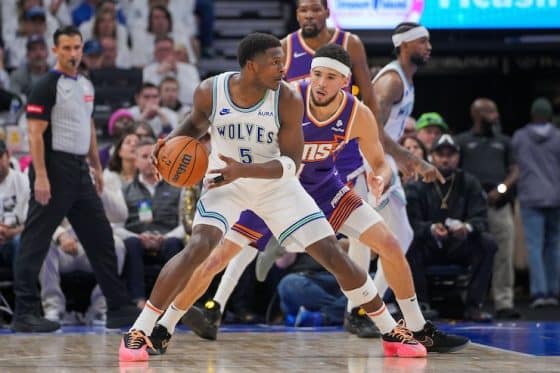NBA
How The Timberwolves Are Using The Suns’ Game Plan Against Them

Key Highlights
- Through two games against the Phoenix Suns, the Minnesota Timberwolves have an offensive rating of 118.8, which is 2.7 points higher than their regular season mark of 116.1
- Anthony Edwards is averaging 7.0 assists, up from 5.1 during the regular season
- Mike Conley Jr. has taken 25 shots, his third-most between any two consecutive games this season
For Anthony Edwards and the Minnesota Timberwolves, their regular season contests facing the Phoenix Suns this year were a thorny, cramped, frustrating, 0-3 experience. In those contests, Edwards averaged 14.3 points on 44.2 percent true shooting — his worst mark against any Western Conference foe — and handed out 11 helpers to 10 giveaways. Phoenix won by 47 combined points. Each margin of victory was at least 10. The Suns gave Edwards and his running mates the business every time, including twice over the final 10 days of the regular season.
None of that’s mattered to open this first-round matchup. Minnesota is giving that business right back, having routed Phoenix in Games 1 and 2 by 37 total points. Neither fourth quarter has really been competitive. Each time, the clean-up crew has closed the game for both sides. The Timberwolves remain two wins away from advancing, but they’ve certainly outclassed the Suns thus far.
As was the case all season en route to the No. 3 seed, their defense is paving the way. They’ve held Phoenix to a 100.0 offensive rating, per Cleaning The Glass. They’re disintegrating dribble handoffs, stymying spread pick-and-rolls, containing transition endeavors and cornering the Suns’ trio of scoring maestros into ill-fated isolations against a gamut of well-qualified stoppers. Rudy Gobert is at the heart of it, playing drop, switching onto stars, coming to the level and turning the paint into a no-fly zone.
Minnesota’s won with this formula the past six months. It went 56-26 because of a historically great defense anchored by a historically great defender. That hasn’t changed.
What has changed, however, is the offense. It’s why Minnesota is pummeling these Suns, which closed the year 7-3 against a gauntlet of postseason opponents — featuring two demolitions of the Timberwolves — and seemed to unearth some cohesion down the stretch. Through two games, the Timberwolves’ 118.8 offensive rating is 8.4 points higher than the playoff average of 110.4. During the regular season, their 116.1 offensive rating was only o.5 points above the league average (115.6). Two games do not make for an evolution, but that’s not what the playoffs are about. They’re about exploiting the varying schemes confronting you each night. Minnesota is doing that.
Part of this stems from Edwards. Behind a 33-point Game 1, he morphed into a pulverizing pull-up shooter, dashing Phoenix’s chances with a slew of spectacle-worthy jumpers off the bounce. Edwards’ Stephen Curry cosplay lasted only for an afternoon. He scored 15 points on 3-of-12 in Game 2 and yet, Minnesota’s offensive rating was still 113.0 (2.6 points above the playoff average). It repeatedly found avenues to punish Phoenix and keep the wheels turning, especially over the final 2.5 quarters (71 points over a 26-minute stretch).
During the regular season — along with Games 1 and 2 — Phoenix has prioritized slowing Edwards as a driver. While Minnesota led the NBA in three-point percentage this season, it was just 20th in frequency and rosters plenty of shooters either amid career years or with slow releases inviting slower closeouts.
His Game 1 explosion didn’t arise because he solved the coverage, but rather because he caught fire and the Timberwolves schemed a little more space for him at times. Prioritizing Edwards’ downhill descents has meant bringing gap help from the wings and strongside stunts from the corners. He’s a locomotive driver, exploding past and through defenders rather than gliding around them with an elegant handle. Crowds can cause trouble for him, particularly when his mercurial jumper won’t comply. Across three regular season meetings, he struggled to navigate that defense, often burrowing into a congested lane, forcing shots or spotting passing windows a beat late. Two turnovers in the first 2.5 minutes of Game 1 didn’t help matters either.













